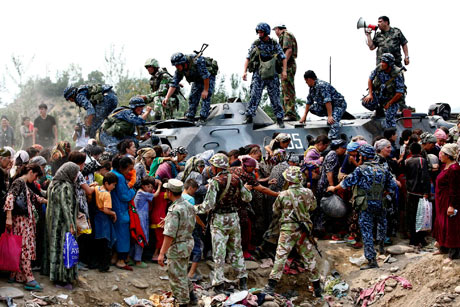By Scott Dempsey, Mercyhurst University
Click here to read the full assessment of the risk of genocide in Kyrgyzstan.
The Sentinel Project has completed an assessment of the risk of genocide in Kyrgyzstan, finding it to be unlikely within the next five years. Our team of student analysts based at Mercyhurst University’s Institute for Intelligence Studies developed the report over the last seven months and structured it around the 30 risk factors in the Sentinel Project’s early warning framework.

Many people were killed and tens of thousands displaced during ethnic violence in southern Kyrgyzstan in 2010. Here, ethnic Uzbeks flee the clashes. (Source)
Since political and economic upheaval in 2010 led to violence between the majority Kyrgyz and minority Uzbeks in southern Kyrgyzstan, most evidence points to a brighter picture in the near future. Although the central government is dominated by ethnic Kyrgyz and is geographically and politically separated from the volatile south where the Uzbek population mainly resides, aid from non-state actors, such as the United Nations Office on Drugs and Crime (UNODC), is helping to stabilize ethnic tensions and reduce the influence of organized crime. While anti-Uzbek sentiment exists at local levels, mainly in the areas around Osh and Jalalabad, the central government is not hostile to Uzbeks and seeks to avoid large-scale conflict. Instances of conflict and protests in the last year have not turned violent. The welfare of citizens is likely to improve along with the economy, further reducing the likelihood of conflict.
Despite this positive outlook, there are a few issues which warrant continued monitoring. There is no doubt that a division exists between Kyrgyz and Uzbeks, and local authorities in the southern city of Osh are unsympathetic to concerns of Uzbeks, who experienced legal and physical persecution after the events of 2010. The persistence of the underlying sociocultural risk factors indicates that any violence within the next five years is likely to have similar causes. Those causes – economic instability and regime change – should be monitored as possible triggers for violence. Drug cartel activity may have also been a factor in the 2010 violence, but recent Kyrgyz and international initiatives are likely to reduce its impact and importance as a trigger.
